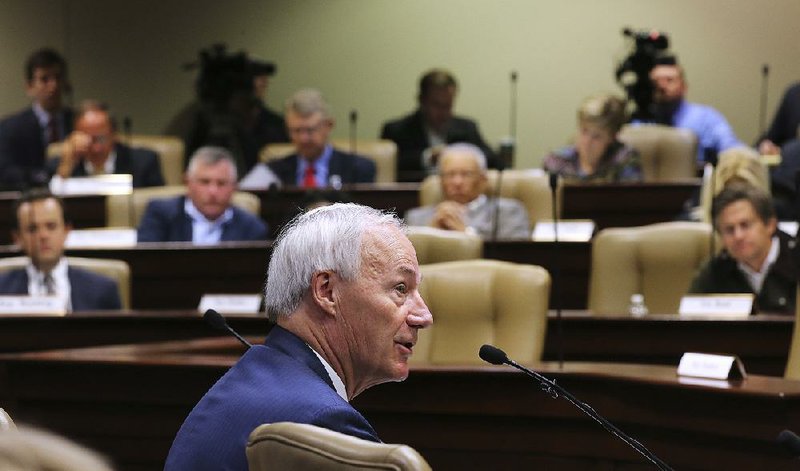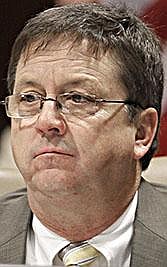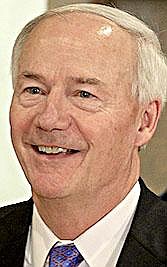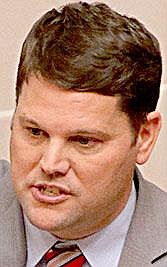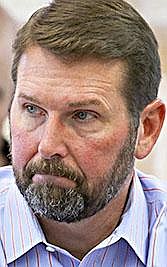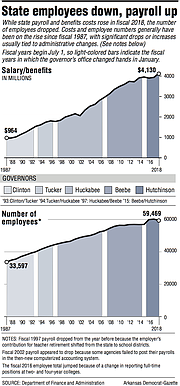The total number of full-time state employees dropped last fiscal year by 754 to 59,469 as their ranks dipped among agencies as well as at higher-education institutions, according to a report.
Over the course of fiscal 2018, which ended June 30, full-time employees at state agencies declined by 440 to 31,019, the state Department of Finance and Administration reported.
The number of full-time workers at the state's two- and four-year colleges slipped by 314 to 28,450, according to the finance department report.
But while the number of workers dropped, the total payroll cost of their salaries and benefits increased by $192 million, or 4.9 percent, to $4.1 billion, according to the finance department.
As it's done in the past, the Arkansas Democrat-Gazette asked the finance department to prepare this report, which is based on a separate Bureau of Legislative Research report computing the average of full-time employees in the last quarter of each fiscal year.
The 754-employee drop -- 1.3 percent -- is the largest decline over a fiscal year since Act 110 of 1985 required agencies and higher-education institutions to report employment. Their ranks declined for the first time in fiscal 2011, by 71, and then by 71 again in fiscal 2014 under former Gov. Mike Beebe.
Another measurement of state employee ranks also shows fewer workers between June 2017 and June 2018. The total number of state employees covered under the unemployment insurance tax law declined from 66,238 in June 2017 to 65,949 in June 2018, said Steve Guntharp, a deputy director at the state Department of Workforce Services. That's a 0.4 percent decline. (Those not covered under the unemployment insurance tax law include elected officials and college students with work-study jobs, he said.)
All state government employees in the United States declined from about 4,589,000 in June 2017 to 4,583,194 in June 2018 based on U.S. Bureau of Labor Statistics figures, Guntharp said. That's a drop of 5,806 employees, or a little more than 0.1 percent.
"I think that the numbers reflect that Gov. [Asa] Hutchinson's efforts to hold down the number of state employees have been effective," said Sen. Larry Teague, D-Nashville, who is a co-chairman of the Legislature's Joint Budget Committee.
Hutchinson said, "For four years, I have talked about transformation of the way the state delivers services and advocated for greater emphasis on efficiency, use of technology in the delivery of services and accountability.
"Not only have my agency directors responded to this goal, but even the leaders in higher education and other independent agencies have worked consistently to right size their departments and to reduce waste. I applaud their partnership and success for the benefit of the taxpayers," the Republican governor said.
Many state employees are in agencies under the direct control of the governor.
But some work for the other six constitutional officers such as secretary of state and attorney general. And some work for the Legislature or the courts; the agencies run by constitutionally separate entities, such as the Game and Fish Commission and the Highway Commission; and higher-education institutions that have some independence under Amendment 33 to the constitution from the governor, who appoints their boards of trustees.
Hutchinson assumed office in January 2015, which was six months into fiscal 2015. He has been the state's chief executive for three full fiscal years and was handily re-elected last month to a second four-year term.
HIGHER PAYROLL
The $192 million increase in payroll costs over the previous fiscal year includes increases in salaries and benefits among both agencies and higher-education institutions, according to a finance department report.
Salaries totaled $3.19 billion in fiscal 2018, up from $3.075 billion in fiscal 2017, the department reported. Benefits totaled $939 million in fiscal 2018, up from $862 million the previous fiscal year.
The total cost of state agencies' salaries and benefits increased by $49 million, or 2.7 percent, to $1.87 billion in fiscal 2018 over the previous fiscal year.
But the total cost of salaries and benefits at colleges and universities increased by $143 million, or 6.7 percent, to $2.25 billion, the department reported.
The payroll increase for agency employees resulted from a new pay plan starting July 1, 2017, said Scott Hardin, a spokesman for the Department of Finance and Administration.
Department of Higher Education Director Maria Markham said Friday that "it looks like a lot of the increase" at public colleges and universities "is due to double counting expenses on both the cash and treasury budgets." She said the total of $2.2 billion "is a bit over-inflated."
Most of the higher-education increase -- $112 million -- was at the University of Arkansas for Medical Sciences, she said.
But Leslie Taylor, a UAMS spokesman, said the university's figures show that the cost of salaries and benefits totaled $1.044 billion in fiscal 2018 -- about a $57 million increase from $987 million in fiscal 2017.
In the past, errors have occasionally crept into state reports on salaries and benefits.
In Hutchinson's first full fiscal year as governor, the payroll cost declined by $53.3 million or 1.35 percent to $3.9 billion in fiscal 2016, according to the finance department.
In fiscal 2017, the total cost increased by $33.3 million or 0.85 percent to $3.93 billion. Last fiscal year, it increased by $192 million to $4.13 billion, the department reported.
"It seems to me that the $3+billion in state payroll is an awful lot of money," Teague said in an email to the Democrat-Gazette. "Throw in matching payroll and it is well over $4 billion."
STATE AGENCIES
At the Department of Human Services, ranks of full-time employees declined by 294 to 7,222, the finance department reported.
"As we've been making structural changes to the agency, we've also been looking at the administrative processes we use," said Marci Manley, a spokesman for the Department of Human Services.
"Streamlining some of our processes has meant we're able to do more with fewer people in some areas. Particularly, as people have vacated administrative positions, we've looked at whether those positions needed to be filled and whether those duties could be handled by the current staff," Manley said in a written statement.
The number of full-time employees at the state Department of Health declined by 76 to 1,942. At the Department of Finance and Administration, the number of employees dipped by 75 to 2,457 .
There are several reasons for the decrease at the Health Department, said department spokesman Meg Mirivel.
"These include a competitive job market, specialized positions that can be difficult to fill, and a number of vacant positions that have been filled by current Health Department employees, which contributes to ongoing vacancies," she said.
The ranks of full-time employees increased by 64 to 1,380 at Community Correction last fiscal year, while numbers increased by seven to 4,082 at the Department of Correction.
Community Correction spokesman Dina Tyler said, "It's just that we had more positions filled from the previous year. And remember, we got those 65 positions from the governor's office a couple of years ago."
Department of Correction spokesman Solomon Graves said, "The department's focus on hiring and retaining staff has been widely reported over the last year. ... We have made great strides in both areas."
When he became governor, Hutchinson said he implemented "a hiring freeze" to require the agencies that reported to him to get his permission to fill vacancies. The number of state employees declined by more than 1,400 since 2015 as a result of the hiring freeze and through normal attrition.
"Earlier this year, I loosened the restrictions on the hiring freeze to give my agency directors more discretion over their staffing needs. However, we continued to closely monitor the number of positions in state government in order to maintain our goal of doing more with less," the governor said.
The number of full-time employees at the constitutionally independent state Department of Transportation inched up by 16 to 3,706 last fiscal year, while their ranks at the constitutionally independent Game and Fish Commission increased by 19 to 594, according to the finance department.
But Sen. Bart Hester, R-Cave Springs, said, "It seems odd to me that ADOT is always beating the drum for more funding to build roads, but every year they hire more staff instead of build more roads.
"Almost all agencies are lowering the [number] of employees while ADOT increases their number of middle management. The people of Arkansas want to see more paved roads, not more salaries," said Hester, who is the Senate Republican leader.
In response, Transportation Department Director Scott Bennett said, "Our emphasis is on efficiency."
"We have put a stronger focus on maintenance, or taking care of what we have. We have tried to hold down administrative costs by keeping employment levels fairly constant. We have increased our maintenance forces but have used technology to be able to keep other numbers low," he said. "We're fortunate that the people of Arkansas have approved two major highway construction programs. To help with those programs, we have supplemented our staff by using consultants. This has been the optimal way to implement these programs successfully."
The ranks of full-time employees in the seven constitutional offices increased by three to 713 last fiscal year, including a dip by three to 53 in the governor's office, according to the finance department.
The number of full-time employees in the judicial branch increased by 11 to 513, including an 11-employee increase to 389 in the Administrative Office of the Courts last fiscal year, while their ranks at legislative branch agencies dropped by five to 424, the finance department reported.
HIGHER EDUCATION
The 314-employee decline at colleges and universities is the first dip in these ranks in at least the past 18 years, according to the finance department report.
The dip came as enrollment declines.
The number of students enrolled at four-year public colleges in the spring of 2018 was 92,552 -- down from 93,083 in the spring of 2017 -- while two-year public colleges had 41,953 -- down from 43,712 -- according to the state Department of Higher Education.
According to the finance department report, the number of full-time employees at UAMS dropped by 53 to 10,336 in fiscal 2018, while their numbers increased by 60 to 4,178 at the University of Arkansas, Fayetteville.
Taylor said the number of UAMS' full-time employees actually declined last fiscal year by 406 to 10,033, and UAMS has reported the correct numbers to the Bureau of Legislative Research.
"The majority of the decrease in the number of full-time employees can be attributed to the reduction in force UAMS implemented in January of 2018," she said.
The report shows a decline of 156 full-time employees to 1,531 at Arkansas State University in Jonesboro and a 65-employee drop to 627 at the University of Arkansas at Pine Bluff.
ASU System spokesman Jeff Hankins said, "While this particular time period shows 1,531 full-time employees for Arkansas State University at Jonesboro, we actually averaged around 1,600 for the year so the decline shown on the report is exaggerated.
"However, we did have an aggressive hiring freeze and implemented a new hiring justification process that contributed to overall lower full-time numbers," he said.
Janet Broiles, chief of staff at UAPB, said the report has an "incorrect" figure for UAPB and "the correct number is 62."
Among two-year colleges, the report showed a 223-employee decline to 344 at the University of Arkansas Pulaski Technical College and a 92-employee increase to 270 at Arkansas State University at Newport.
Pulaski Tech has about 355 full-time employees and "in the past year we have reorganized, refrained from refilling open positions and moved some full-time positions to part-time as we respond to changes in our enrollment," said Pulaski Tech spokesman Tim Jones.
Hankins said that ASU-Newport "has been reporting numbers incorrectly based on a misunderstanding of some of the guidelines.
The number of full-time employees should have been 170 for the fourth quarter of fiscal 2018 and the campus had 164 in the fourth quarter of 2017, "so there's a net increase of only six for full-time employees," he said.
THE FUTURE
Hutchinson wants the Legislature to enact his proposal to reduce the number of state agencies reporting to him from 42 to 15 in the regular legislative session starting Jan. 14. He said he expects continued savings in the delivery of services.
"I expect the number of state employees to decline over time through attrition -- just as we have seen over the course of the last four years," he said. "Layoffs have never been a consideration under my plan."
CORRECTION: An earlier version of this story incorrectly quoted Gov. Asa Hutchinson. Hutchinson said, "However, we continued to closely monitor the number of positions in state government in order to maintain our goal of doing more with less."
SundayMonday on 12/16/2018
